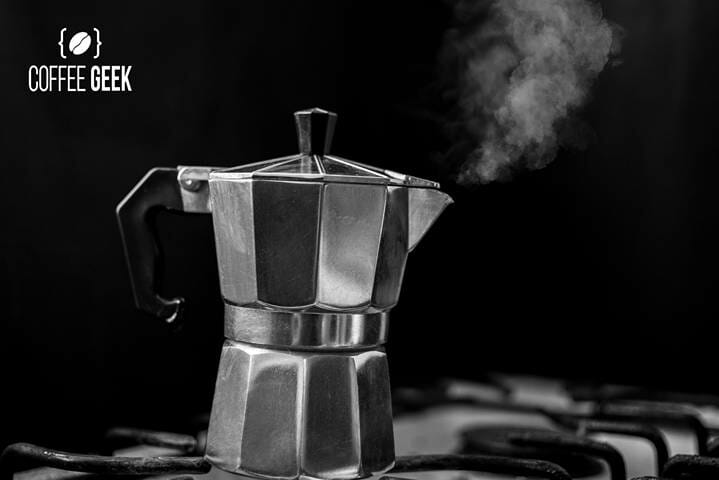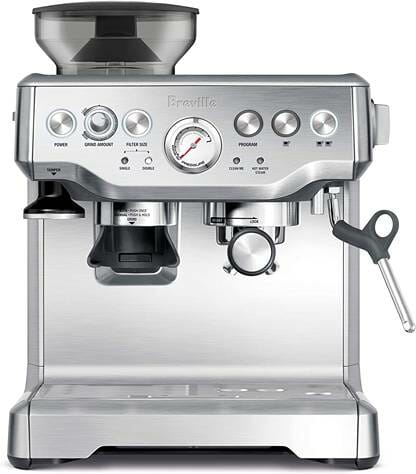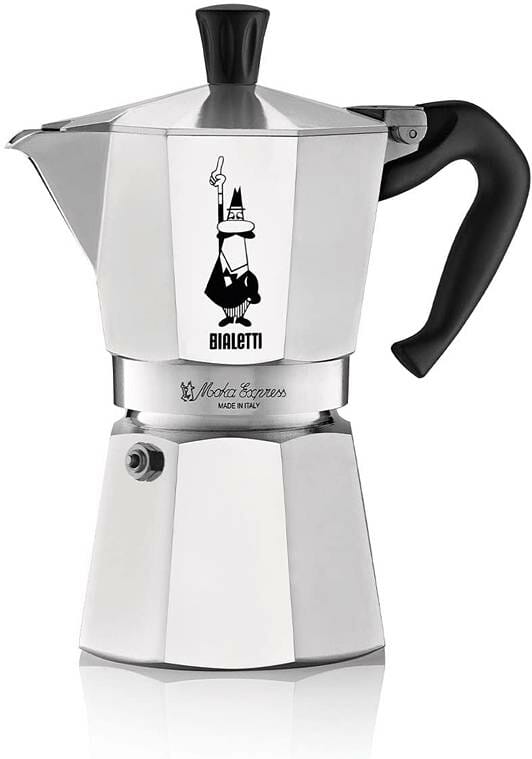Moka pot vs espresso machine – why not have both? After all, they each offer unique brewing methods that result in delicious coffee.
But if you’re trying to decide which one is right for you, it can be tough to choose.
I’m sure you’ve seen both a Moka pot (marketed as a stovetop espresso maker) and an espresso machine in your local coffee shop.
They both look similar, but they brew coffee in very different ways.

In this article, I’ll explain the difference between a Moka pot and an espresso machine.
I’ll also give you the pros and cons of each brewing method, so you can decide which one is right for you. Let’s get started!
What is a Moka Pot?

Let’s first make things right. While Moka pots are commonly marketed as stovetop espresso machines, they don’t actually make genuine espresso coffee.
So, if you’re looking for a true espresso experience, a Moka pot is not the right choice for you.
I know, I know. It’s confusing. So let me explain.
Moka pots brew coffee by forcing hot water through coffee grounds under pressure. This results in a strong, concentrated coffee that is similar to espresso.
However, Moka pots don’t produce enough pressure to create authentic espresso.
The pressure that Moka pots create is only around 1 to 2 atmospheres. For comparison, modern espresso machines create around 8 to 10 atmospheres of pressure.
So, while Moka coffee is strong and concentrated, it’s not technically espresso.

Moka pots were invented in Italy in 1933 by Alfonso Bialetti. They became popular because they were an easy and affordable way to make coffee at home.
Moka pots are still popular today, especially in Europe.
Let’s take a closer look at how Moka pots work.
How Does a Moka Pot Work?
As I mentioned, a Moka pot brews coffee by passing water through the grounds under pressure, similar to an espresso machine.
The Moka pot has three main parts: the base, the filter basket, and the top chamber.
The base is where you put the water. The filter basket is where you add the coffee grounds. Once the water in the base is heated, it starts to boil and creates steam.
This steam forces the hot water up through the coffee grounds in the filter basket and into the top chamber.

The coffee then continues to brew in the top chamber until it’s ready to be poured.
- You add water to the base and coffee grounds to the filter basket.
- The Moka pot is placed on the stovetop and heated until the water boils.
- As the water boils, it is forced up through the coffee grounds and into the top chamber.
- The brewed coffee ends up in the top chamber, where it can be poured into a cup and enjoyed.
Moka pots come in a variety of sizes, from small 2-cup pots to large 12-cup pots.
The brewing process is the same regardless of the size of the pot. However, the larger the pot, the longer it will take to brew the coffee.
You’re more likely to brew bitter coffee with a Moka pot than it is with an espresso machine. This is because the water is in contact with the coffee grounds for a longer period of time.
If you want to avoid bitterness, it’s important to use quality coffee beans and grind the beans to the correct size.
I’ve written an article on how to make Moka pot coffee, which goes into more detail on this.
The Pros and Cons of Moka Pots

Now that you know how Moka pots work, let’s take a look at the pros and cons of this brewing method.
Pros
- Moka pots are easy to use and don’t require any special skills or training.
- They’re relatively inexpensive, especially when compared to espresso machines.
- Moka pots are small and compact, so they don’t take up a lot of counter space.
- You can make coffee with a Moka pot on the stovetop, so you don’t need an electric outlet.
- Moka pots make a strong, concentrated coffee that is 2 – 3 times stronger than regular drip coffee.
- They’re easy to clean and require very little maintenance.
Cons
- Coffee brewed with a Moka pot is not as strong as espresso.
- The brewing process is slow, so you have to wait a few minutes for your coffee.
- The quality of the coffee can vary from batch to batch.
- You may make brew bitter coffee with a Moka pot.
What is an Espresso Machine?
An espresso machine is a more modern coffee brewing method that uses pressure to brew coffee.
This coffee brewing method is more complicated than a Moka pot, but it produces authentic espresso.
These machines have come a long way since their invention in the early 1900s.
They now come in a variety of shapes and sizes, from small single-cup espresso makers to large commercial machines.

Modern espresso machines brew ground coffee with near-boiling water under high pressure. This process extracts more flavor from the beans, resulting in a rich and strong cup of coffee.
So, how do espresso machines work? Let’s take a look.
How Does an Espresso Machine Work?
Like I said before, brewing coffee with an espresso machine is a more complex process than brewing with a Moka pot.
While there are many different espresso machines on the market, they all work using the same basic principle.
The espresso machine forces hot water through tightly packed coffee grounds at high pressure (usually 8 bars or higher).
This process extracts more flavor from the beans, resulting in a strong and super concentrated cup of espresso.
The espresso machine has three main components: the boiler, the grouphead controls, and the portafilter.
The boiler is used to heat water to the brewing temperature.
Some espresso machines have a separate boiler for brewing and steaming milk, while others have a single boiler that does both.
The grouphead controls the flow of water and pressure during the brewing process. It’s important to have a consistent flow of water and pressure to brew quality espresso.

The portafilter is where the coffee grounds are placed. It’s attached to the grouphead and holds the coffee grounds during brewing.
Espresso machines can be manual, semi-automatic, or automatic.
Manual espresso machines require the most effort on the part of the user, while automatic espresso machines do most of the work for you.
Manual espresso machines have a brew lever that the user must operate to start the brewing process.
The user also has to control the flow of water and pressure by adjusting the grind size and tamp pressure.
This requires a lot of skill and practice to get the espresso just right.
Semi-automatic espresso machines have a brew lever that the user must operate to start the brewing process.
However, the machine automatically controls the flow of water and pressure, so the user doesn’t have to adjust the grind size or tamp pressure.
This takes some of the guesswork out of brewing espresso and is a good option for those who are still learning.
Automatic espresso machines are the most user-friendly option.
These machines can streamline the entire process, including properly grinding and dosing grinds into the portafilter, so the user doesn’t have to lift a finger
This guide on how to make espresso will show you how to operate an espresso machine, no matter what type you have.
And if you’re looking for an espresso machine for your home, check out our list of the best espresso machine.
The Pros and Cons of Espresso Machines

Espresso machines have a few advantages over other coffee brewing methods. I’ll go over some of their pros and cons so you can decide if one is right for you.
Pros
- Can brew coffee with a higher concentration of flavors and aromas.
- Espresso machines come in a variety of styles, so you can find one that fits your needs and budget.
- You can use an espresso machine to make a variety of espresso-based coffee drinks.
- The quality of espresso brewed by an espresso machine can be very consistent.
Cons
- You need to have some knowledge and skill to brew a good espresso.
- Espresso machines can be expensive.
- Espresso machines require more maintenance than other coffee brewing methods.
- Cleaning an espresso machine can be a time-consuming process.
Moka Pot vs Espresso Machines: The Key Differences
I’ve gone over some of the pros and cons of espresso machines. Now, let’s compare espresso machines to Moka pots to help you decide which coffee brewing method is best for you.
Flavor

Compared to regular drip coffee, espresso shots are 5 – 10 times more concentrated. The coffee has a very intense, full-bodied flavor.
The espresso brewing process extracts more flavors and aromas from the coffee beans, resulting in a richer cup of espresso.
This is made possible by the higher water temperature and pressure used in espresso machines.
Nevertheless, a Moka pot still brews coffee with a higher concentration of flavors and aromas than regular drip coffee (2 – 3 times more concentrated).
The coffee has a full-bodied flavor, but it’s not as intense as espresso.

The Moka pot brewing process also may result in espresso that tastes bitter. As said before, I have a detailed guide on how to make espresso in a Moka pot that will help you avoid this.
Please check the link I shared at the beginning of this post.
Brewing Time
It takes about 24 – 30 seconds to brew an espresso shot. The espresso brewing process is very quick because the water is forced through the coffee grounds at very high pressure.
On the contrary, it takes 4-5 minutes to brew coffee with a Moka pot. The Moka pot uses steam pressure to force the water through the coffee grounds.
The process is slower because the Moka pot doesn’t generate as much pressure as an espresso machine.
Brewing Temperature
The ideal brewing temperature for espresso is between 195 – 205 degrees Fahrenheit (90 – 96 degrees Celsius).
This is the temperature at which the water extracts the optimal amount of flavors and aromas from the coffee beans.
The ideal brewing temperature for coffee brewed in a Moka pot, on the other hand, is between 200 – 208 degrees Fahrenheit (93 – 98 degrees Celsius).
Brewing Pressure
The espresso brewing process requires high pressure (8 – 10 bars). Thus, this resulted in a very quick brew time.
The Moka pot brewing process only uses 1 – 2 bars of pressure. The Moka pot doesn’t have a pump, so the pressure is generated by steam. This results in a slower brew time.
Durability
Moka pots are very durable and can last for years with proper care. Espresso machines are also long- lasting, but they require more maintenance than Moka pots.
They have more moving parts than Moka pots, so they require more frequent cleaning and descaling.
If you don’t maintain your espresso machine properly, it will break down more quickly.
Cost
Espresso machines can be expensive. A good quality espresso machine can cost hundreds or even thousands of dollars.
Moka pots are much less expensive, with most models costing less than $100.
So, if you’re looking for a cheap way to brew espresso-quality coffee, a Moka pot is a good option.
But if you’re willing to spend more money for a higher-quality cup of coffee, an espresso machine is the better choice.
Ease of Use
Espresso machines can be difficult to use, especially if you’re a beginner. There’s a lot of technique involved in making a perfect shot of espresso.
It can take practice to get the brew time, temperature, and pressure just right.
Moka pots are much easier to use than espresso machines.
There’s no need to worry about brew time, temperature, or pressure. Just add water and coffee, put the Moka pot on the stove, and wait for the coffee to brew.
The Verdict: Moka Pot or Espresso?
If you’re looking for an easy and affordable way to brew espresso-quality coffee, a Moka pot is a good option.
If you want the highest-quality cup of coffee, an espresso machine is the better choice.
But be warned, they can be difficult to use and require more maintenance than Moka pots.
Do you have a Moka pot or espresso machine? What do you think of it? Let me know in the comments below.
FAQs
Is Moka Pot as Strong as Espresso?
No, Moka pot coffee is not as strong as espresso. Moka pots only generate 1 – 2 bars of pressure, while espresso machines generate 8 – 10 bars of pressure. The pressure generated by an espresso machine extracts more flavors and aromas from the coffee beans, resulting in a stronger cup of coffee.
Is Moka Pot Filter or Espresso?
Moka pot coffee is more like an espresso. Both brewing methods use pressure to extract flavors and aromas from the coffee beans. The main difference is that a Moka pot is a simple low-tech espresso maker that can produce espresso-like coffee.
Is a Moka Pot Only for Espresso?
Yes, a Moka pot is only for espresso-like java. It’s not possible to make regular filter coffee with a Moka pot. Since some pressure is required to brew coffee in a Moka pot, it can only be used to make espresso-style coffee.
Why Is Moka Pot Coffee So Good?
Moka pot coffee is so good because it’s very close to espresso. It’s less concentrated than espresso, but it still has a strong flavor.



